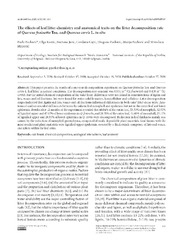Приказ основних података о документу
The effects of leaf litter chemistry and anatomical traits on the litter decomposition rate of Quercus frainetto Ten. and Quercus cerris L. in situ
| dc.creator | Pavlović, Pavle | |
| dc.creator | Kostić, Olga | |
| dc.creator | Jarić, Snežana | |
| dc.creator | Gajić, Gordana | |
| dc.creator | Pavlović, Dragana | |
| dc.creator | Matić, Marija | |
| dc.creator | Mitrović, Miroslava | |
| dc.date.accessioned | 2021-01-14T12:51:39Z | |
| dc.date.available | 2021-01-14T12:51:39Z | |
| dc.date.issued | 2020 | |
| dc.identifier.issn | 0354-4664 | |
| dc.identifier.uri | https://www.serbiosoc.org.rs/arch/index.php/abs/article/view/5800/425 | |
| dc.identifier.uri | https://radar.ibiss.bg.ac.rs/handle/123456789/4086 | |
| dc.description.abstract | This paper presents the results of a one-year decomposition experiment on Quercus frainetto Ten. and Quercus cerris L. leaf litter in natural conditions. The decomposition rate constant was 0.831 yr−1 (Q. frainetto) and 0.458 yr−1 (Q. cerris). For the initial chemical composition of the oaks’ litter, differences were not found in concentrations of lignin and fats, waxes and oil fractions, but were found for water-soluble matter, hemicellulose and cellulose. Later decomposition stages indicated that lignin and fats, waxes and oil fractions influenced differences in both oaks’ litter decay rates. Ana-tomical analysis revealed differences between the oaks in leaf mesophyll and epidermis but not in the entire leaf and lower epidermis. Results after 12 months of the experiment revealed that 48.04% of the entire leaf, 53.30% of mesophyll, 32.93% of lignified upper and 47.67% of lower epidermis in Q. frainetto, and 28.70% of the entire leaf, 31.60% of mesophyll, 25.17% of lignified upper and 20.93% of lower epidermis in Q. cerris were decomposed. Reduction in leaf thickness mainly was caused by the reduction of mesophyll parenchyma, composed of easily degradable plant materials. Leaf tissues with the most recalcitrant plant materials were lignified upper epidermis, covered by a thick cuticle composed of fats and waxes, and xylem within the leaf veins | sr |
| dc.language.iso | en | sr |
| dc.publisher | Serbian Biological Society | sr |
| dc.relation | info:eu-repo/grantAgreement/MESTD/inst-2020/200007/RS// | sr |
| dc.rights | openAccess | sr |
| dc.rights.uri | https://creativecommons.org/licenses/by-nc-nd/4.0/ | |
| dc.source | Archives of Biological Sciences | sr |
| dc.subject | oak forest | sr |
| dc.subject | chemical composition | sr |
| dc.subject | ecological interactions | sr |
| dc.subject | leaf anatomy | sr |
| dc.title | The effects of leaf litter chemistry and anatomical traits on the litter decomposition rate of Quercus frainetto Ten. and Quercus cerris L. in situ | sr |
| dc.type | article | sr |
| dc.rights.license | BY-NC-ND | sr |
| dcterms.abstract | Павловић, Драгана; Костић, Олга; Павловић, Павле; Јарић, Снежана; Митровић, Мирослава; Павловић, Марија; Гајић, Гордана; | |
| dc.rights.holder | © 2020 by the Serbian Biological Society | sr |
| dc.citation.issue | 72 | |
| dc.citation.volume | 4 | |
| dc.identifier.doi | 10.2298/ABS200902048P | |
| dc.identifier.scopus | 2-s2.0-85099148854 | |
| dc.identifier.wos | 000604979700010 | |
| dc.citation.apa | Pavlović, P., Kostić, O., Jarić, S., Gajić, G., Pavlović, D., Pavlović, M., et al. (2020). The effects of leaf litter chemistry and anatomical traits on the litter decomposition rate of Quercus frainetto Ten. and Quercus cerris L. in situ. Archives of Biological Sciences, 72(4), 543–553. | |
| dc.citation.vancouver | Pavlović P, Kostić O, Jarić S, Gajić G, Pavlović D, Pavlović M, Mitrović M. The effects of leaf litter chemistry and anatomical traits on the litter decomposition rate of Quercus frainetto Ten. and Quercus cerris L. in situ. Arch Biol Sci. 2020;72(4):543–53. | |
| dc.citation.spage | 543 | |
| dc.citation.epage | 553 | |
| dc.type.version | publishedVersion | sr |
| dc.identifier.fulltext | https://radar.ibiss.bg.ac.rs/bitstream/id/8036/bitstream_8036.pdf | |
| dc.citation.rank | M23 |

